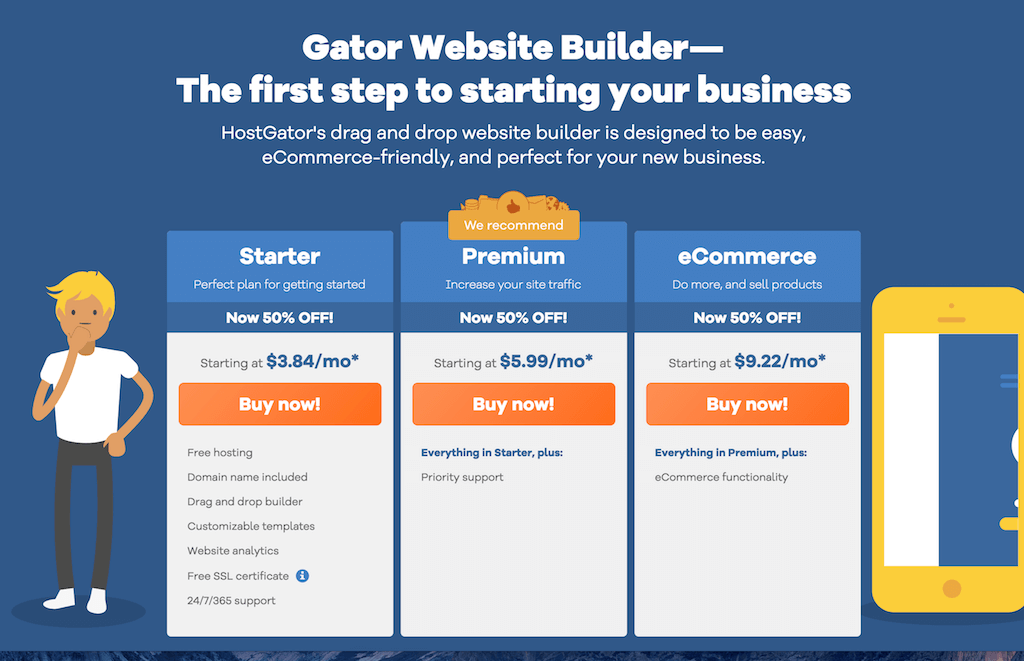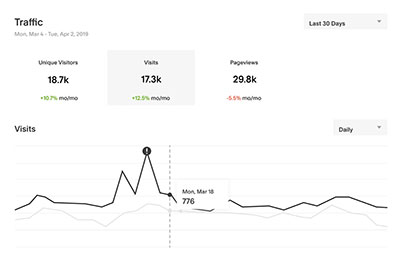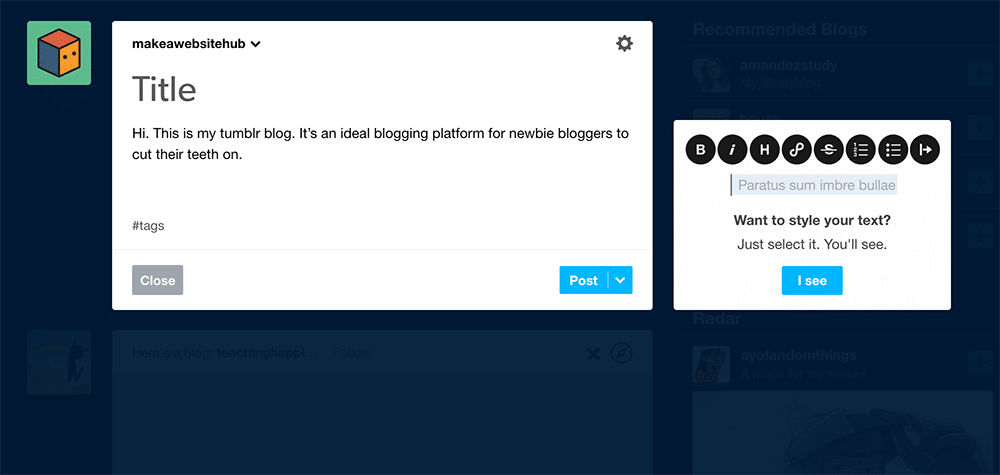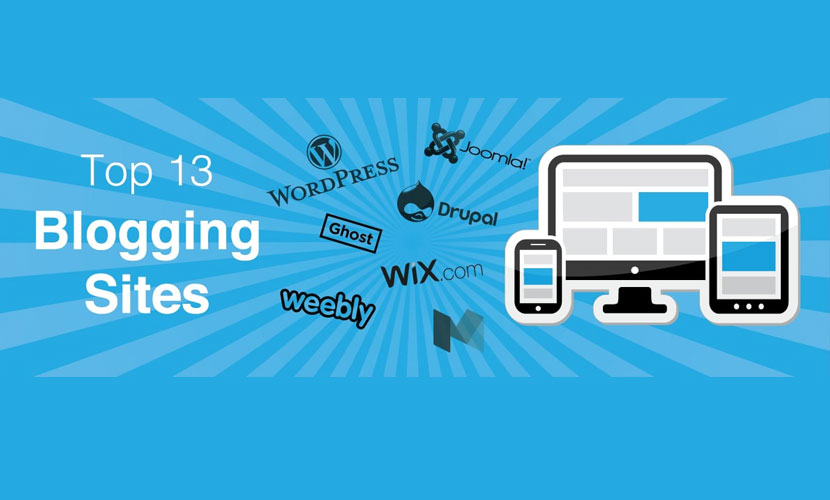Reviews
Best Blogging Sites Comparison Guide 2020
A Comprehensive Guide To Premium and Free Blogging Platforms

Best Blogging Sites: Blogging is a great way to connect with the world. Whether you blog to express your passion for your hobbies, blog to connect on a personal level with others, or blog to help promote a business, it can be a great way to connect with the world. In this article, I’ll be reviewing each of the popular blogging sites available today.
Since blogging is much more than writing or posting photos, finding the best platform for your needs is important. You will want to have a platform that is easy to use and provides you with the customization tools you are looking for to give your audience everything they need to read and interact with your blog.
If you have never blogged before, you will want to choose blog platforms that cater to beginners. This means in many cases you will be giving up the option to change HTML or CSS code. If you have been blogging for a while, these options for coding may be more important to you.
As a blogger, you will also have to decide whether you want to pay for the options that come with some platforms or stick to the free platforms that may have fewer options available. This choice can be determined by what your blog’s focus is and whether you plan to make money from the blog itself.
There are also blogging sites that provide both free and paid services, which can be useful when your small blog turns into a big hit. Here are some of the top blogging sites that are available and the pros and cons of using each to create your next home on the Internet.
The Major Blogging Platforms Compared ( Best Blog Sites – Free & Premium)
These popular blogging platforms all have positives and negatives, especially when you take into consideration your level of skills as a blogger and as a coder. The longer you blog, the more skills you will pick up, so it is important to either find a platform that meets your needs at the time or to find a platform that gives you the ability to change the type of services you get to better serve your needs and the needs of your blog’s audience.

The .org version of WordPress provides many of the same features as its .com counterpart, but it also provides additional customization features for any blogger. This WordPress option works out well for folks who want to have complete control over the customization of their blog, monitor traffic via Google Analytics, and freely monetize their website. But it is not a platform that is easy for beginners to use effectively but there are lots of free and paid options to learn WordPress.
WordPress.org lets you install your own custom plugins and free themes to make your blog look exactly how you want. To use this platform for your blog, you will have to find your own web host, perform routine backups and maintain the blog on your own.

For people who are just starting their blogging journey, I recommend that they use BlueHost for their blog hosting as they offer an easy WordPress installation process, reliable uptime, and excellent support. Their hosting services are also officially recommended by WordPress. In fact, I use Bluehost for many websites that I own.
You can now get BlueHost’s high-quality hosting plan for just $2.95 per month – (36 months sign up) plus you get a free domain name. Normally $7.99 per month. Personally, I’d go for the Choice Plus plan for just $5.45 ( was $14.99 per month ) It’s actually the same price as the Plus plan!
Use this link to get a FREE DOMAIN NAME with your hosting.
If you’re looking for a managed WordPress hosting solution which then I’d also recommend Cloudways.
Pros:
- An extremely flexible platform gives you complete control over every single aspect of your site
- Over 54,000 plugins, apps, and extensions available for full customization
- An endless variety of mobile responsive themes to choose from
- An excellent and cost effective way of getting started online, especially if you’re just starting out in business or blogging
- Search engine and social media-friendly
- Large developer community with a ton of support options
Cons:
- Beginner-friendly, but there is a slight learning curve
- Security, performance, and backups are your responsibility
Pricing
As an open-source solution, WordPress is completely free to use. However, you’ll need to pay for a domain name, hosting, and a premium theme should you choose to use one. You’ll also need to pay for any premium plugins you may want to add to improve the flexibility of your blog. Again, we recommend Bluehost for hosting & domain.
Perfect for…
- Professional bloggers and those wanting full site control
- Online businesses
- Business blogs
- Just about any site online today
Wix – (free / premium blogging platform)

Wix.com is a website builder platform that is mainly set up to build websites, but it can also be used to start a blog. The key feature of Wix is that the web pages or blogs you create with the platform are supported for portable devices, so your readers can see your work easily displayed on their smartphone or tablet. Wix also provides a good amount of information and support for its users, including email and phone support for customized answers to your questions. Although Wix offers an easy-to-use solution it has a lot of negatives from an SEO perspective.
Pros:
- Easy-to-use interface with no coding skills required
- Plenty of third-party apps and templates to customize your site
- Quick and easy to set up with hosting included
- Provides a lot of design options
- Unique A.I. feature will design your blog automatically
- Comes with lots of stock images to choose from
Cons:
- Free account features Wix branding and limited capabilities
- Limited number of free apps
- Limited ecommerce functionality
- Stuck with a template once it’s chosen
- Unable to migrate your site to another host
- Add-on charges can rack up quickly
Pricing
While Wix offers a free account, it’s extremely limited and full of Wix branding, so it’s only ideal for learning the ropes of web design. Wix paid packages to start at $5 a month. At this price, you get a custom domain, 500MB of storage, and 1GB of bandwidth.
Higher plans offer more storage, bandwidth, apps, and the ability to build an online store. The highest plan also comes with around-the-clock VIP support, but it will run you $25 a month.
Perfect for…
- Artists, musicians, and other creative types
- People with little to no web development experience
- Businesses in need of a blog to complement their website
Gator by HostGator – (premium blogging platform – hosting + domain required)

Created by the popular hosting company HostGator, Gator is an easy-to-use, drag-and-drop blogging platform and website builder you can use to build any website, including blogs. Gator can even be used to create an online store.
The Gator builder is separate from HostGator’s website hosting. Many bloggers use HostGator hosting with WordPress to start a blog, but Gator provides you with an all-in-one hosting solution and blogging platform, allowing you to control every facet of your site from a single location.
Pros:
- User-friendly, drag-and-drop website builder and blogging platform
- Quick and easy setup with no technical know-how needed
- Free domain name and SSL certificate included
- Performance, security, and backups handled by HostGator
- Adding ecommerce functionality only takes a few clicks
Cons:
- No free account, but there is a money-back guarantee
- Limited apps and extensions
- Can only access ecommerce features with a higher-priced plan
Pricing
There are three different Gator website and blog builder plans. The Starter plan starts at $3.84 a month and includes free hosting, free domain name and SSL certificate, the drag-and-drop builder tool, customizable templates, site analytics, and 24/7 support.
The Premium plan starts at $5.99 a month and includes everything in the Starter plan plus priority support. Lastly, the eCommerce plan starts at $9.22 a month. It includes everything in the other plans but offers ecommerce functionality as well.
Perfect for…
- Beginning bloggers
- First-time website owners
- Anyone interested in an all-in-one blogging/hosting solution
Drupal – (free blogging platform – hosting + domain required)

Drupal is a great option for blogs associated with businesses because it is not just a blogging platform, but a complete content management system. This means that along with your blog, web pages, and other online content can be created and organized within this platform. Drupal does not host blogs for users, so bloggers using this platform will have to find their own host someplace else. Drupal is also not a platform that readily accommodates beginners, so it is better for those upgrading from a free blogging platform rather than for the blogger just starting out.
Pros:
- Great for building advanced, feature-rich sites
- Access to tons of free modules and features
- Custom content types for added flexibility
- Built-in access control system helps manage user permissions
- Great taxonomy system for handling tons of data
- Core multilingual site support
Cons:
- Not very beginner-friendly and as easy to use as WordPress or Joomla
- Installation requires technical expertise
- Need to add modules to get rid of Drupal’s out-of-the-box feel
Pricing
Drupal is an open-source platform, so it’s completely free.
Perfect for…
- Developers
- Designers
- Editors
- Anyone with the patience to learn the ropes

If you are looking for a full content management system, Joomla is another great option for bloggers. In terms of ease of use, Joomla may have more of a learning curve than WordPress but can be much easier to use than Drupal. Many businesses and large corporations prefer this type of platform because it can give you flexibility with a wide range of content options.
Joomla is an open source content management system and free to use, however, you will need to buy hosting and a domain name. For many novice bloggers, this can be a high cost unless the blog is attached to an existing business that already generates a profit.
Pros:
- Very flexible and suitable for creating several types of websites, not just blogs
- Dozens of professional-looking templates
- Easy to make design changes
- Lots of extensions available for more blog features and functionality
Cons:
- Not beginner-friendly
- Requires some HTML and CSS coding knowledge
- Security, performance, and backups are your responsibility
Pricing
Like several other blogging platforms that require a little knowledge and work by their users, Joomla is completely free to download. When building a blog with Joomla, you simply need to pay for a domain and hosting.
Perfect for…
- Technically advanced users
- Business websites
- Large, dynamic blogs
- Online stores
WordPress.com – (free / premium blogging platform)

WordPress is one of the most popular free blogging platforms on the Internet. Millions of users like the options it provides for simple, free blog creation and maintenance. The platform is free and offers services such as hosting, the ability to have a custom domain, integrating your blog with social media and popular features such as comments and polls are available without installing plugins. A number of paid upgrades are also available. The biggest issue with this version of WordPress is that options such as custom themes, plugins, and editing HTML are not available. However, WordPress.com also has a sister site, WordPress.org that provides many more customization options.
Both WordPress.com and WordPress.org are also known for the detailed amount of support provided. Not only do these sites have the standard tutorials to get you started building on these platforms, but WordPress also has a large community of users that are more than willing to help out a fellow user with common questions and concerns about various aspects of blogging on WordPress. With all of the information available, it can be easy to learn this platform quickly so you can start customizing your site without too much trouble. I am a huge WordPress fan and recommend it to all my clients, check out my free tutorial if you want to start blogging with WordPress.
WordPress.com in my opinion is probably the best free blogging site around. If you’re a novice to blogging and you’re just starting out on your blogging journey, then WordPress.com is worth considering.
Pros:
- Hosting is included
- Installation wizard makes setup a breeze
- Streamlined, easy-to-use interface
- Built-in community functions
- No need to worry about site maintenance
- Dedicated support
Cons:
- Free version is very limiting
- Few customization options
- Access to third-party plugins and themes only available with Business plans
- Free account includes branding and ads
Pricing
WordPress.org is open-source and completely free. WordPress.com is not. While a free version is available, it’s extremely limiting and filled with branding.
The paid plans range in price from $4-$25 a month with annual billing. With each tier you go up, you receive more storage space, support, and features.
Perfect for…
- Hobby bloggers
- Beginner bloggers
- Non-dynamic websites
WordPress.com is an excellent starting point for people new to blogging. As your blog grows and you want greater control, you can easily migrate your blog from WordPress.com over to WordPress.org and continue growing from there.

There are many great platforms out there for starting your own blog. They include sites with customizable HTML and CSS for those with more advanced skills. Medium.com is a place to share your thoughts and writing with a wide audience. Unlike some of the other blogging platforms, Medium has a built-in audience, which makes it often debatable whether it’s a publisher or a platform.
Signing Up
Individuals or businesses can sign up for a Medium account since it’s free. Those individuals or businesses can publish their own posts, add their voice and style to other publications, or curate posts or publications. Publications are collections of posts that are curated by users and Medium itself.
Posting and Commenting
Readers can comment on other’s posts, recommend posts and follow and share their favorites. The process is like many other blogging platforms except Medium has a slight twist on the commenting process. Readers can highlight and focus on parts of the text and make their comments in the margins.
Embedding
The medium allows third-party embedding from other sites around the web. Creators can embed videos from YouTube or Vimeo. They can add content from Twitter, Vine, Instagram, and SoundCloud.
Traffic and Views
On every post, readers get to see how many minutes it would take to read a post. They’ll immediately know whether they have time to read through the story or whether they should bookmark it for later. Another feature on the front page for viewers to see is how many views it’s gotten on the platform. Recommendations and reads are also available to creators. The dashboard allows creators to see where the traffic originated from too.
Best Practises to Create Posts
There is no minimum word count for posts, but Medium suggests that content over 400 words are popular. The headline should be compelling and clickable, but should also stick to the topic of your content. They recommend high-quality photographs for the content as well.
Great for Beginners
The platform is a terrific starting point for beginners to the blogging world. It’s simple to use and doesn’t require coding knowledge. It’s also used by brands to recycle their content onto another platform to gain further reads and new readers of their content. A highly recommended free blog site for small business owners and freelance professionals.
Pros:
- Completely focused on blogging and content creation
- Quick and easy to sign up and get started
- Excellent user interface
- Ability to embed content from Twitter, YouTube, and more
Cons:
- Very few customization options
- You don’t control your content
- No site migrations
- Limited marketing features ad monetization options
Pricing
Medium is free to use. You can hook your domain up to individual stories, but you’re unable to sync its with user accounts.
Perfect for…
- Professional writers and bloggers
- Hobby bloggers
- Anyone looking to improve their brand visibility through great curated content
Squarespace – (premium blogging platform – $12 – $40 pm)

When it comes to customization, Squarespace is a platform that offers a wide variety of options. The best part about customizing your blog on this platform is that you can change everything without knowing how to code. It is also a platform that lets you expand your services which is a great option if you are using your blog for your business. It also has its own analytics dashboard, so you can see where your website’s traffic is coming from, what pages your visitors are looking at, how they’re engaging with your content and so much more.

The downside to Squarespace for bloggers is that theme and plugin support is not great as it could be. If you want these options on Squarespace, knowledge of code will be necessary.
Pros:
- Very beginner-friendly and easy to use
- Hosting and custom domain included
- Variety of professional design templates to choose from
- Built-in SSL encryption
- Ecommerce functionality
- 24/7 support
Cons:
- Limited to only using the platform’s features
- Very few third-party integrations
- Personal plan allows for limited number of pages and contributors
Pricing
Like many other paid blogging platforms, Squarespace operates via the subscription model. You can choose from one of two plans. The Personal plan is $16 a month and the Business plan is $26 a month.
Both plans offer unlimited bandwidth and storage. However, the Business plan also includes several marketing features, the ability to customize designs, and the ability to create an online store.
Perfect for…
- Professional and hobby bloggers
- Business owners
- Ecommerce stores
- Portfolio websites

Another blogging platform that is great for businesses who want to maintain a blog on their website is Weebly. This platform provides a wide range of easy-to-use features, including drag and drop options for those who do not want to learn coding to make simple changes. Since Weebly can be used for blogging and web building, business owners find this platform a lot easier to use than other platforms where blogs and websites are created separately. To start with you can sign up for their free plan which will give you some practice writing and constructing blog posts without spending any money.
Related Guides: Weebly Pricing – Weebly Review
Expert coding options are also not available on this platform. If you are a blogger who wants to be able to change and customize HTML or CSS on the blog, this Weebly.com makes it difficult to do so because it focuses its services on those who want to quickly create and update a blog without a lot of hassle.
Pros:
- Easy to use with drag-and-drop blog building tool
- Good selection of mobile apps
- Strong SEO features
- Integrates with Google Analytics
Cons:
- Few integrated features
- Limited number of third-party integrations
- Difficult to export sites
- Free plan features Weebly branding and subdomain
Pricing
Weebly offers a free account, but it’s limited to 500MB of storage and includes Weebly branding and a subdomain. As far as paid plans go, the initial plan comes with a custom domain and costs just $4 a month.
If you want site statistics, membership options, video backgrounds, and other features, you’ll need to go with one of the higher-tier plans, which costs $8-$25 a month. If you want to create an online store, Weebly has separate ecommerce plans that cost a little more.
Perfect for…
- Beginner bloggers with little technical skills
- Business websites in need of blogging capabilities
- Portfolio websites
Typepad – (premium blogging platform $8.95 to $49.95 pm)

Typepad is a blogging platform that provides an easy-to-use interface for beginning and experienced bloggers. The platform provides a wide range of themes to choose from as well as plugins so you can make your blog your own. A key drawback to using Typepad is that all of the blogs are hosting by them on their server, so you do not have the option to use the platform with your own blog host. It is also a platform that makes editing code difficult because it is geared towards bloggers who may not be as confident in editing HTML code for example.
Pros:
- Active dashboard for quick drafting and publishing of content
- Several social media integrations
- Google-friendly posting features
- Supports live audio and video podcasts
- Unique tip jar and other monetization features
- Both blog and individual post data analysis
Cons:
- Free 14-day trial, but Typepad is a paid platform
- Restrictions on the number of blogs you can create
- Few integrated widgets
Pricing
Typepad offers several pricing plans to meet the needs of a variety of users. The Plus plan is $8.95 a month. With it, you get unlimited storage, an array of design templates, domain mapping, and personal support.
The next step up is the Unlimited plan at $14.95 a month. With it you get everything in the Plus plan as well as fully customizable designs and the ability to publish unlimited blogs. Meanwhile, the Premium plan is $29.95 a month, and it includes all of the above plus priority support. There is also an enterprise plan for $49.95 per month.
A free 14-day trial is available with all of the plans.
Perfect for…
- Professional bloggers
- Industry influencers
- Large organizations
Blogger.com – (free blogging platform)

If there is one platform that is easy for beginners to use, it is Blogger. This is a free blogging platform that is simple to use for anyone just starting out with a blog. With this platform a user can just type their content, add photos and publish. Blogger.com also lets users edit HTML and add widgets to blogs, which many blogging sites for beginners do not offer. Blogger is a Google service, so users will have to have a Google account and may find the Google-related add-ons redundant or useless for their blog. It is also one of the blogging platforms that many bloggers grow out of once they learn more about blogging since it does not have any upgrade options. Here’s a more detailed comparison of Blogger versus WordPress.
Pros:
- Free and easy to use
- Takes care of hosting, maintenance, and more
- Several mobile responsive templates to choose from
- Integrates with Google Drive and other Google products
- Useful anti-spam comment feature
Cons:
- Limited blogging tools
- Zero integration with third-party apps and services
- Few design options
- Ads are displayed on your blog
Pricing
Blogger has been around for what seems like forever, and while it lacks the functionality and design options of WordPress and several other of today’s popular blogging platforms, it costs absolutely nothing to use. In fact, the only expense you’ll have with a Blogger blog is a custom domain, but going this route is completely up to you.
Perfect for…
- Hobby bloggers
- Personal blogs
Tumblr.com – (free blogging platform)

Tumblr is a blogging platform that is very popular with younger audiences. Traditionally created for “microblogging”, the platform itself is very simple to use and enables the user to obtain a free website ( although you will never own the content or domain name. One of the best features of Tumblr is that it is focused on the community of bloggers, so it provides a variety of options for sharing and reblogging content. The downside to blogging on Tumblr.com is that it does not focus on text content, but photos and GIFs. Visual bloggers will love it, but writers may want to find another platform to use. The idea of reblogging content may also lack appeal with bloggers, particularly if you are blogging material that you want to have complete control over copyright and other such protections.
Pros:
- Free and easy to use
- Includes hosting, but uses a subdomain
- Integrated sharing and re-blogging social features
- Several design options
- Easy to publish images, videos, audio, and other multimedia
Cons:
- Features are quite limited
- Backing up your files and content isn’t impossible, but it’s definitely not easy
Pricing
Like Blogger and several other blogging platforms, Tumblr is completely free to use. There are costs for a custom domain and third-party themes and apps, but these are optional.
Perfect for…
- Hobby bloggers
- Personal and microblogs
Ghost – (premium blogging platform – $29 – $199 pm)

Ghost is an open source blogging platform that provides a simple, clean interface that makes it very easy to use. It also provides a live preview of your post while you are writing it, so you can easily correct any writing or coding mistakes as you go along. This platform can be great for beginners because of its ease of use, but expert bloggers may also prefer it because of its interface compared to other blogging services. The downside to Ghost is that it can be difficult to install at first but once it is, it can be a great tool for any blogger.
Again for running a blog on Ghost you will require web hosting – I recommend BlueHost.
Pros:
- Emphasis on blogging
- Clean, streamlined, and intuitive interface
- Built on JavaScript, so it’s super-fast
- Live blog post previews
- Built-in social media and SEO capabilities
- Accelerated Mobile Pages function
- Zero setup for hosted version
Cons:
- Customizing could be easier
- Limited configuration options
- Limited number of themes
- Self-hosted version is difficult to set up
Pricing
The self-hosted version of Ghost is completely free, but it’s difficult to set up and definitely not for everyone. Fortunately, Ghost offers paid hosted plans as well. As with most paid plans, the more you play, the more storage, bandwidth, and features you receive.
The Basic plan costs $29 a month, or $19 if you opt for annual billing. With it, you get a blog, SSL encryption, a CDN, and up to 50,000 monthly page views.
For $79 a month, the Standard plan provides up to 500,000 monthly page views, more resources, and priority support. The top-tier Business plan is $199 a month, and with it you get a whopping one million views per month, subdirectory use, a 99.9 percent uptime guarantee, and more.
Perfect for…
- Bloggers in need of advanced technical solutions
- Professional bloggers with a growing online presence
- Serious publishers
The best way to find the right platform for your needs is to understand whether each platform focuses on beginners or experts, how much it costs to use, and how much customization your audience will demand. Remember that it can be easy to upgrade to a better platform in most cases, so starting with an easy-to-use option is great for anyone just starting out in the blogosphere and wanting to learn how to start a blog.
That’s the end of our guide. If you haven’t decided on a blog platform yet – don’t worry.
You can head right over to BlueHost to get your web hosting and pick up a subscription to Envato Elements too. That way, you can play around with all of these different blogging platforms, while at the same time having access to some of their most premium themes, and unlimited stock photos too. That way, you can get started with actual hosting and unlimited creative freedom for less than $35 per month!
The Ultimate Blogging Platforms Comparison Chart 2019 – Both Premium & Free Blogging Sites
To help you even further with your quest to find the best blogging platform for your new or existing website or blog, I have put together a pretty comprehensive comparison chart. The chart is easy to digest and covers the pros and cons, features, detailed information, and ratings on each blogging platform for both premium and free blogging options.
>>>Join The One Funnel Away Challenge<<<






























